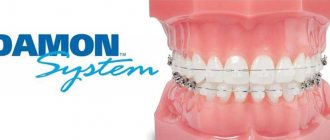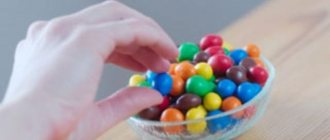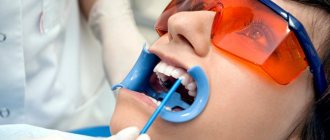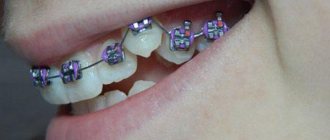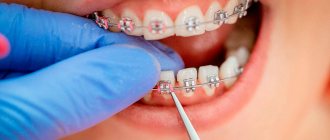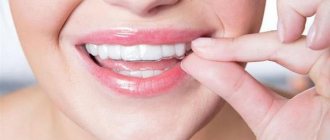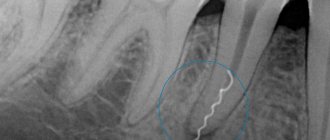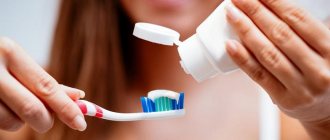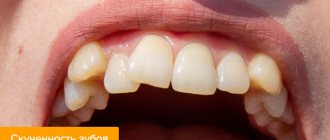Problem: parents contacted a 12-year-old boy. The child's fang is protruding on one side.
Solution: treatment was performed with the Damon brace system. The canine was put in place, the bite was corrected.
Orthodontist consultation
At the consultation, the parents said that previously the fangs had protruded on both sides, but treatment with an orthodontic plate at the local orthodontist put one fang in place, but the second could not be put in place. The treatment with braces with tooth extraction on one side proposed at the district clinic did not appeal to the parents, and they came to the orthodontist at Dial-Dent.
The consultation revealed an incorrect position of the canine, crowded teeth, and incorrect inclination of the front teeth. The distant chewing teeth, the so-called “sevens,” have not yet erupted, so now is the best time to start orthodontic treatment - there is potential for jaw growth, and the treatment will be easier for the child, and the result will be more stable.
The orthodontist spoke about the possibilities of orthodontic treatment, different brace systems and their features, approximate cost and timing. It usually takes about 1.5-2 years to achieve a stable result. No tooth extraction will be required, as modern braces successfully solve problems such as lack of space.
Since the teenager and his parents were serious about orthodontic treatment with braces, the boy was sent for in-depth diagnostics: photometry, OPTG, TRG in the lateral projection, taking impressions of the dentition. A consultation with an osteopath and speech therapist is also recommended, since malocclusion is interconnected both with the position of the head and posture, as well as with the position of the tongue and the correct development of the facial muscles.
Photometry before orthodontic treatment:
Panoramic photo of teeth before treatment:
TRG in lateral projection:
Speech therapist consultation
Speech therapist Tsukor T.B. revealed incorrect position of the tongue, weakness of the tongue muscles, and infantile type of swallowing. A set of exercises for practicing at home is given.
Osteopath consultation
Osteopath An T.Z. Conducted osteopathic diagnostics. Since osteopathic disorders are of a descending type, that is, changes are caused by malocclusion, osteopathic correction is planned throughout the entire orthodontic treatment to adapt the body to the new position of the jaw.
The orthodontist combined the results of research and consultations, made calculations and drew up a treatment plan.
Of the external or internal braces proposed for treatment, the Damon braces system was chosen. To make the teenager less embarrassed about braces, Damon Clear ceramic braces will be installed on the upper teeth, which are almost invisible on the teeth. Metal braces will be installed on the lower teeth, since when communicating, the lower teeth are covered with the lip, and the braces do not attract attention.
Fangs are sticking out - what to do?
The most correct answer to the question: “Fangs are sticking out, what should I do?” - contact an experienced orthodontist. At the first meeting with the patient and his parents, the head of the orthodontic department of Dial-Dent, O.A. Baranova said that treatment with braces will help return the fangs to their place. At the first consultation, the doctor names the approximate time frame, as well as the estimated cost of treatment, which depends on the chosen brace system. The doctor warns about possible difficulties and nuances, which will be clarified after an in-depth diagnosis. The doctor also informs you what tests need to be completed, how the process of correcting the bite with braces proceeds, and what steps need to be completed. If the patient (in this case, the consent for treatment of a minor patient is given by the parents) is ready for treatment, then the doctor issues a detailed list of subsequent actions. The patient needs to have photometry, a panoramic photograph of the teeth, impressions, TRG in the lateral projection and undergo a consultation with an osteopath and hygienist.
Commentary by orthodontist O.A. Baranova: “Orthodontists have to deal with the problem of “fangs sticking out” all the time. Most often, a lack of space for fangs occurs due to underdevelopment of the jaws in childhood. The main cause of this disorder is a lack of chewing load. Modern children have begun to eat softer foods. In the absence of adequate chewing load, jaw growth slows down, and this, in turn, leads to a lack of space for permanent teeth. The canines are replaced in the bite after the incisors and premolars, and they often do not have enough space in the dentition. If at the age of 11-13 years the child’s fangs do not fit into the dentition, contact an orthodontist. This is the most favorable period for treatment.”
Photometry before orthodontic treatment:
Panoramic photo of teeth before treatment:
The diagnosis made by the orthodontist is crowding of the teeth in the upper jaw. The doctor recommends the Damon brace system, since this system has two grooves in the bracket lock. At one stage of treatment, the doctor will use two arcs: the first will move the fangs, the second arc will hold the incisors in a stable state so that the fangs do not “drag” them along with them. Damon metal braces are an excellent modern solution. Their main advantages: low cost, miniature form, effective impact with the correct calculations by the doctor.
The treatment tactics are as follows: stage-by-stage fixation of braces, moving the teeth of the upper row to free up space, moving protruding fangs to free places with stabilization of the incisors, the stage of wearing orthoelastics to create precise interdental contacts, retention period (preservation of treatment results after removal of braces).
Start of orthodontic treatment
Before installing braces on the teeth, a professional teeth cleaning was carried out, as a result of which old plaque was removed, the teeth were polished so that the plaque sticks less, and training was provided in brushing teeth with braces.
Braces are installed on the teeth in two stages for gradual adaptation to new sensations. A starter hygiene kit was issued, which contains everything necessary for caring for teeth with braces, and explains in detail what is intended for what. The starter kit includes orthodontic wax, orthodontic toothbrush, toothpaste, brushes, dental floss, and monobrush. The set was prepared by specialists and is given as a gift when fixing braces.
Damon braces on teeth:
The first arches, which are installed at the beginning of treatment, are made of material that has a memory effect. The doctor bends the arch according to the shape of the dentition, and the arch strives to acquire the original correct shape, thereby changing the position of the teeth. The Damon brace system exerts weak forces on the teeth, but the impact is constant. This combination of constant pressure and gentle forces produces the most consistent orthodontic treatment results.
Typical problems.
NORMALLY, the permanent incisors are located “evenly” in the dentition without “protrusion” or “sagging” to the side. This indicates a harmoniously occurring process of physiological replacement of milk teeth with permanent ones.
If there has been early removal of baby teeth in children and, as a result, permanent chewing teeth are displaced forward, improper closure of the dentition occurs and crowding of teeth appears in the area of the frontal and chewing teeth.
A common problem in the period from 9 to 12 years is poor oral hygiene, which is associated with the characteristics of the psychological development of children. As a result, caries develops in “young” permanent teeth. Most often, the 6th chewing teeth (1st molars) are affected in the area of fissures (natural depressions of the teeth located between the cusps of the tooth).
Fissure caries, remaining unnoticed, develops rapidly and is quickly complicated by inflammation of the nerve of the tooth (pulpitis).
PHOTO: The child's lower permanent incisors erupted in the second row. In this situation, it is necessary to free up space by removing the mobile baby teeth so that the permanent teeth can take the correct position in the dental arch.
Orthodontic treatment with braces
Visits to the orthodontist took place every 1.5-2 months. Each time, the orthodontist pays attention to hygiene, monitors the progress of treatment, carries out the manipulations outlined in the treatment plan - changes the arches, adds the necessary elements to the brace system.
The protruding fang fell into place a month after the start of treatment. But the treatment ends only when a stable correct position of all teeth has been achieved and physiological interdental contacts have been created.
While wearing braces, in addition to brushing your teeth twice a day, it is recommended to have your teeth professionally cleaned every six months. This will help remove plaque accumulation in hard-to-reach places (around braces and gums, under arches). Long-term accumulation of plaque leads to demineralization of the enamel and the appearance of white spots on the teeth, which become very noticeable after the braces are removed.
Before brushing your teeth with Air Flow:
After professional teeth cleaning with Air Flow:
To correct the bite, you need to wear orthodontic elastics - elastic rings of different lengths, which are attached to special hooks on braces or arches. The child must secure the oroelastics himself, changing them daily. The orthodontist shows how the elastics are secured and checks whether the patient has understood everything correctly.
It is better for parents to monitor this process, since the duration and result of orthodontic treatment depends on the correct wearing of elastics. You should always have spare elastics with you, since breaks in wearing are extremely undesirable, and if one elastic breaks, both must be changed so that the traction is symmetrical.
After 1 year and 1 month:
The structure of the fangs
The canines of the upper jaw are shaped like an irregular cone. The cutting edge is shaped like a triangle, which is limited by three teeth - a pronounced middle one and two outer ones. The area of the tooth facing the lip (vestibular) has a convex shape and gradually approaches the lingual.
On the lingual part of the tooth there is a longitudinal ridge that divides the dental crown into two facets: the lateral part has the largest area. The upper canine has a pronounced crown curvature and root deviation.
The root of the tooth is quite thick and has a shape slightly compressed from the sides. Wider in anteroposterior dimension. The lateral and medial surfaces are very wide and have barely noticeable grooves.
The tooth has one, wide enough and accessible if treatment is necessary, root canal.
The canines located on the lower jaw are smaller in size than the upper ones, and the shape of the crown is close to the upper lateral (side) incisors. They are slightly narrower and longer than the upper canines. The medial surface is in a straight line with the root line. The cutting edge is less pronounced. The distal part of the cutting edge is longer than the medial one.
The labial surface of the lower canines is less convex and pronounced than that of the upper ones, and the lingual surface can be either straight or slightly concave.
The lower fangs have a slightly shorter tooth root than the upper ones, but they have absolutely no differences in shape. In rare cases, anatomical pathology occurs in which the root is divided into two parts.
The canines of both jaws have quite pronounced external differences in the dental crown, but at the same time the dental cavities are very similar.

